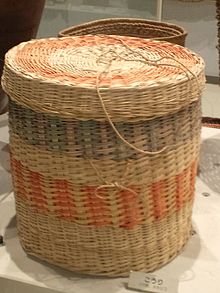容器
容器 (英語:Container) 是一種基礎工具[1][2]。泛指任何可以用於容納其它物品的工具,可以部份或完全封閉,被用於容納、儲存、運輸物品[3]。物體可以被放置在容器中,而容器則可以保護內容物。




歷史
編輯人類使用容器的歷史至少有十萬年,甚至可能有數百萬年的歷史[4]。第一個容器可能是用於儲存食物[4][5] ,這讓食物能保存更長的時間,也能便於攜帶,還能免受其它動物的侵擾。儲存食物的容器對人類社會的發展具有重大的意義,這在靈長類動物之中是一種獨有的行為.[6]。最早的容器可能是自然界中原有的物體,例如在塔魯族[7]和夏威夷族[8] 的文化中,有使用空心葫蘆的案例[9]。在這之後,出現了籃、木器和陶器。
隨著人類的技術不斷演進,新的材料、新的生產方式接連誕生,容器的形式也不斷改變[10]。最早的玻璃瓶是在腓尼基生產的,在賽普勒斯和羅得島一帶挖掘出腓尼基人所生產的透明玻璃瓶,長度自3英吋至6英吋不等[11]。這些腓尼基人在西元前創作的作品被推測用於裝載香水及其他物品[12],古羅馬人從腓尼基人那兒學到了玻璃的製作方法,並且製造了很多精細的玻璃瓶,大小相對較小。到了18世紀初,玻璃瓶的尺寸已經有公定的標準[13]。
1810年,法國人Philippe de Girard造訪倫敦,他找上英國商人彼得·杜蘭作為自己的代理人以推銷自己的嶄新想法——錫罐[14]。而罐頭這個概念是源自法國廚師尼古拉·阿佩爾,阿佩爾之家成為了世界上第一家商業罐頭工廠。
大規模運輸作業一直是一個大難題,主要是因為20世紀時使用的木製貨櫃容易破損,這也讓海關官員在檢查貨物進口時缺乏標準程序[13]。現代的標準貨櫃起源於1950年代,且很快就普及至各地。電腦輔助設計讓容器的設計變得更專業化、產品也更為精準[15]。
現代特色
編輯在設計容器時,有幾種必須考慮的要點:
光是具有防震、防潮的功能,可不能算得上一個好的容器。精心設計的容器必須是易於使用的,也就是說、使用者必須要能很輕易地開啟或關閉容器,放入或取出內容物,即使在運輸時也不減損其功能。此外、良好的容器必須要有清晰而便利的標示,形狀要有利於堆放和儲存,在使用壽命將至時,必須要能便於回收。[16]
容器的類型
編輯以下列舉數種常見的容器:
參考文獻
編輯引用
編輯- ^ David P. Braun, "Pots as Tools", in J. A. Moore and A. S. Keene, eds., Archaeological Hammers and Theories (1983), pp. 108-134.
- ^ Karen Gayle Harry, Stephanie Michelle Whittlesey, Trixi Bubemyre, Pots, Potters, And Models: Archaeological Investigations at the SRI Locus of the West Branch Site, Tucson, Arizona (2005), p. 283: "The perspective taken in this chapter is that ceramic containers are tools (Braun 1983) and, as a crucial part of the technological repertoire, can provide considerable information about activity organization, production technology, food-preparation and storage technology, settlement function, and economic organization".
- ^ Soroka, W. Illustrated Glossary of Packaging Terms. Institute of Packaging Professionals. 2008: 51. ISBN 1-930268-27-0.
- ^ 4.0 4.1 Clive Gamble, Origins and Revolutions: Human Identity in Earliest Prehistory (2007), p. 204.
- ^ David A. Munro, A Place For Everything (1968), p. 92.
- ^ Bernard Grant Campbell, Human Evolution: An Introduction to Mans Adaptations (2009), p. 306.
- ^ Sameera Maiti, The Tharu: Their Arts and Crafts (2004), p. 178.
- ^ Irving Jenkins, The Hawaiian Calabash (1989), p. 5.
- ^ Chuck Groth, Exploring Package Design (2005), p. 3.
- ^ Lewandowski, Krzysztof. Growth in the Size of Unit Loads and Shipping Containers from Antique to WWI.. Packaging Technology and Science. 2016, 29 (8-9): 451–478 [2017-01-13]. ISSN 1099-1522. (原始內容存檔於2016-11-15).
- ^ Perrot and Chipiez, Histoire de l'art, v iii, 734-744
- ^ George Rawlinson, History of Phoenicia, 1889, Green Longmans publisher, 583 pages
- ^ 13.0 13.1 Warren Belasco, Roger Horowitz, Food Chains: From Farmyard to Shopping Cart, p. 98-99.
- ^ Geoghegan, Tom. BBC News – The story of how the tin can nearly wasn't. Bbc.co.uk. 2013-04-21 [2013-06-04]. (原始內容存檔於2013-06-06).
- ^ Geoff A. Giles, Design and Technology of Packaging Decoration for the Consumer Market (2000), p. 82: "Container designers also found that shrink sleeves gave them new-found freedom to design containers that until then had been viewed as impossible to decorate".
- ^ Anthony F. Buono, Henri Savall, Socio-economic Interventions in Organizations (2007), p. 231.
來源
編輯- 書籍
- Yam, K.L., "Encyclopedia of Packaging Technology", John Wiley & Sons, 2009, ISBN 978-0-470-08704-6